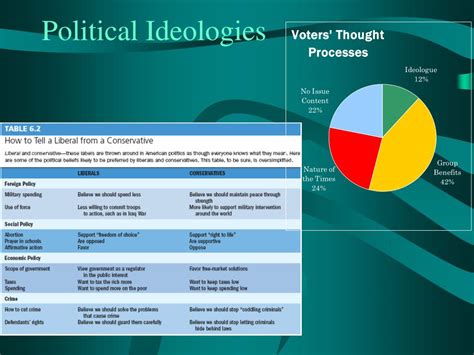In the realm of political science, understanding the concept of political ideology is paramount for grasping the complex dynamics of the political sphere. Political ideology, according to the College Board’s Advanced Placement Government and Politics framework, encapsulates the fundamental beliefs about the role of government, the distribution of power, and the desired social order. These beliefs form the backbone of political parties, guide policymaking, and shape the interactions between citizens and the state. Embark on a comprehensive exploration of political ideology, its defining characteristics, and its multifaceted manifestations in the political arena.

Political Ideology: A Core Component of Political Science
Political ideology serves as a compass for political actors, providing a framework for their decision-making and shaping their political aspirations. As a foundational pillar of political science, it enables researchers to discern patterns in political behavior, interpret policy choices, and understand the ideological divides that often define political discourse.
Defining Characteristics of Political Ideology
Distinctive features characterize political ideologies, setting them apart from other political concepts:
-
Comprehensive Framework: Ideologies encompass a holistic worldview, offering a comprehensive set of principles that guide political thought and action across various realms, from economics to social welfare.
-
Values-Based: Ideological beliefs are deeply rooted in values and principles that guide individuals’ perceptions of the proper role of government and societal organization.
-
Dynamic: Ideologies are not static but rather evolve over time, reflecting societal shifts, economic developments, and the emergence of new political actors.
-
Influence Behavior: Ideologies have a profound impact on political behaviors, shaping individual voting patterns, party affiliations, and collective political activism.
Manifestations of Political Ideology
Political ideologies manifest themselves in various forms, each reflecting a distinct set of values and beliefs:
-
Liberal Ideology: Championing individual rights, limited government intervention, and free markets, liberalism emphasizes the importance of individual liberty and choice.
-
Conservative Ideology: Emphasizing tradition, order, and stability, conservatism advocates for a limited role for government and a focus on free markets and traditional values.
-
Socialist Ideology: Advocating for a more equitable distribution of wealth and increased government control of the economy, socialism prioritizes social justice, equality, and the welfare of the masses.
-
Libertarian Ideology: Upholding a staunch commitment to individual rights and minimal government interference, libertarianism seeks to maximize personal freedom and free market principles.
Ideology and the Political Spectrum
Political ideologies are often arranged along a left-right spectrum, with different ideologies occupying different positions based on their views on government intervention, social welfare, and economic regulation. This spectrum serves as a useful tool for analyzing ideological differences and understanding the ideological landscape of a society.
Common Mistakes to Avoid
When studying political ideologies, it is important to avoid common pitfalls that can hinder understanding:
-
Oversimplification: Resist the temptation to reduce ideologies to simplistic caricatures. Ideologies are complex and multifaceted, and attempting to oversimplify them can lead to a distorted understanding.
-
Conflation with Party Platforms: While ideologies often align with political parties, it is important to recognize that ideologies are broader in scope and may transcend party affiliations.
-
Assuming Ideologies Are Fixed: Ideologies are not static but rather evolve over time, shaped by societal changes and new political currents.
-
Ideological Purity: Avoid the trap of seeking ideological purity, as real-world ideologies often embrace elements from different ideological traditions.
Effective Strategies for Studying Political Ideology
To effectively grasp the nuances of political ideology, consider these strategies:
-
Examine Historical Context: Place ideologies within their historical context to understand the factors that shaped their development and evolution.
-
Analyze Ideological Texts: Study the writings and speeches of influential thinkers to gain firsthand insights into the core principles of different ideologies.
-
Compare and Contrast: Identify similarities and differences between ideologies to discern their unique characteristics and ideological nuances.
-
Consider Ideological Impact: Explore the practical implications of ideologies on policymaking, political discourse, and societal outcomes.
Conclusion
Political ideology is the lifeblood of political science, providing a framework for understanding the beliefs, values, and aspirations that shape the political arena. By delving into the defining characteristics, manifestations, and common pitfalls associated with political ideology, students of AP Government and Politics gain a deeper appreciation for the complexities of political life. Embracing effective strategies for studying political ideology empowers individuals to navigate the ideological landscape and engage in informed civic discourse.
